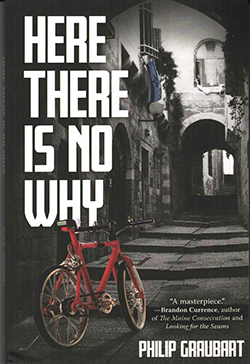Here There Is No Why by Rabbi Philip Graubart; Virginia Beach, Virginia: Köehlerbooks; © 2024; ISBN 9798888-244852; 276 pages; $19.95

 SAN DIEGO — In a Nazi concentration camp, a thirsty Jewish prisoner finds an icicle but before he can put it to his mouth, it is slapped out of his hands by a kapo. The prisoner looks with bewilderment at his tormenter and asks “why?” The kapo responds: “Here there is no why.”
SAN DIEGO — In a Nazi concentration camp, a thirsty Jewish prisoner finds an icicle but before he can put it to his mouth, it is slapped out of his hands by a kapo. The prisoner looks with bewilderment at his tormenter and asks “why?” The kapo responds: “Here there is no why.”
Fast forward some 40 years later to 1983. Jewish author and theologian Chaim Lerner, a fictional Israeli equivalent to the real- life Elie Wiesel at least in his influence on the broad questions raised by the Holocaust, is found sprawled dead on the pavement below his third-floor balcony. The ruling is that it was suicide.
However, in contravention to this novel’s title, Lerner’s former student Judah Loeb, who in the interim has become a Pulitzer Prize-winning American journalist, accepts a book assignment in 2005 to probe why Lerner committed suicide. Was he, as some commentators suggested at the time, Hitler’s 6,000,001st victim, overcome by Holocaust-caused PTSD? Or, was it something related to his contemporary life in Israel?
For that matter, was it really a suicide? Could he have been pushed by someone over the railing? Was it actually murder?
Author Rabbi Graubart provides us with an intellectual whodunnit. Possible suspects are Israeli settlers whom Lerner opposed on philosophical and theological grounds in his books and essays. Another set of suspects are the modern Orthodox rabbis whom Lerner had also criticized, He argued that by their refusal to recognize other streams of Judaism – Conservative, Reform, Reconstructionist as examples – they divide the Jewish people at a time when Jewish unity is imperative.
Graubart, himself, is a Conservative rabbi, who served as spiritual leader of Congregation Beth El in La Jolla and now teaches at the trans-denominational San Diego Jewish Academy. Although Conservative, he represents both sides of the debates in this stimulating book.
In his investigation, Loeb’s interrogation of leading suspects involved learned discussions about Judaism’s teachings – which Graubart, teacher that he is, makes understandable to lay readers.
Loeb takes with him to Israel his 15-year-old daughter Hannah, whom he has raised as a single parent the last 10 years after his wife Mary committed suicide – so the fact that he and his daughter experienced the loss of a beloved family member colors Loeb’s investigation which Hannah, a wise teenager, assists.
Other essential characters are Lerner’s wife, Zahava, then a Knesset member supporting a right-wing prime minister, and Michal, Loeb’s first lover who in the interim became Lerner’s daughter-in-law.
If you enjoy mysteries, especially those involving religiously knowledgeable Jewish principals, this one will engage you without let-up from beginning to end. Mazal tov to Rabbi Graubart for simultaneously teaching and entertaining readers.
*
Donald H. Harrison is publisher and editor of San Diego Jewish World.